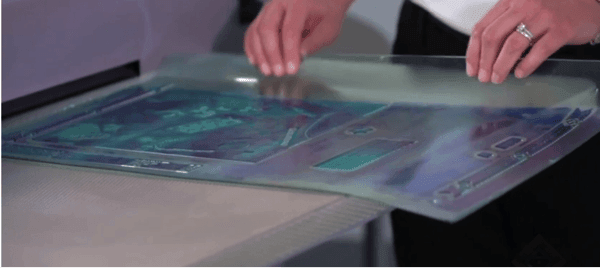Cleaning Flexo Plates – Timing is Everything
I started out writing this post on “Best Practices – Cleaning Flexo Plates”, however, most of us know the basics of flexo plate cleaning. We know the importance of selecting appropriate cleaning solutions, and methods of cleaning and wiping the plate to avoid damage to screens. Plus, we all know that plates should be cleaned immediately after a press run… or do we?
Common sense tells us that cleaning flexo plates sooner rather than later is a good thing. Once a job is finished the ink remaining on your plates immediately begins to dry. Screens and fine reverses trap dried ink deposits making it difficult to remove. Manual cleaning with a horsehair brush or special cleaning pad may be ineffective for deep cleaning these areas.
Ink often remains in these areas even after the best of efforts are made manually cleaning the plate. Plates are then sent to storage and the next time they are used, print quality is degraded as the relief in screens is greatly reduced by the dried ink deposits. Some times the dried ink deposits break free causing additional problems.
Timing is critical. Cleaning flexo plates immediately after the press run minimizes the time for the ink to dry and makes for easier, more effective plate cleaning. So why do people procrastinate when it comes to plate cleaning? Cleaning flexo plates is never fun. It’s time-consuming and always seems to prevent us from doing other more important tasks that need to be done, like the next press run. Plus, there’s the natural tendency to feel you will get to it in a few minutes, but that turns into an hour or longer.
Automation is a beautiful thing. In recent years we have seen the introduction of automatic plate washers. Automating the plate washing function facilitates long-lasting and consistent flexo plate performance. It also helps address the problem of plate-cleaning procrastination by making it easy to clean flexo plates.
Washing flexo plates automatically reduces plate damage and offers superior performance in cleaning flexo plates. Manually cleaning plates may cause damage due to excessive scrubbing or soaking plates for an extended time to remove dried ink deposits.
Dirty flexo plates are feed into the automatic plate washer immediately after a press run manually or automatically using transfer rollers. By automating the process of cleaning flexo plates, plate washers like the Ovit Flexo Matic provide better control over hard-to-clean reverse areas and screens and offer unsurpassed consistency so plates remain in top condition, time and again.
You can now clean, rinse and dry flexo plates much quicker, more effectively, and consistently with an Ovit Flexo Matic plate washer. You simply feed plates into the system and they are cleaned and dried automatically, and ready for storage,
noted Jessica Harkins Harrell, Technologies Manager for Anderson & Vreeland, Inc.
There are environmental benefits using automatic flexo plate washers since they extend the life of flexo plates for repeated use, and recycle the plate washing liquid and rinse water for extended use. These plate washers also assist with compliance of safety rules for the operator and environment since they automate the process of cleaning and drying flexographic plates.
Anderson & Vreeland prepared a video demonstrating the automatic cleaning process with an Ovit Flexo Matic plate washer. Watch and see why there’s no reason to procrastinate washing flexo plates when you have an automatic plate washer. Automation is a beautiful thing.




